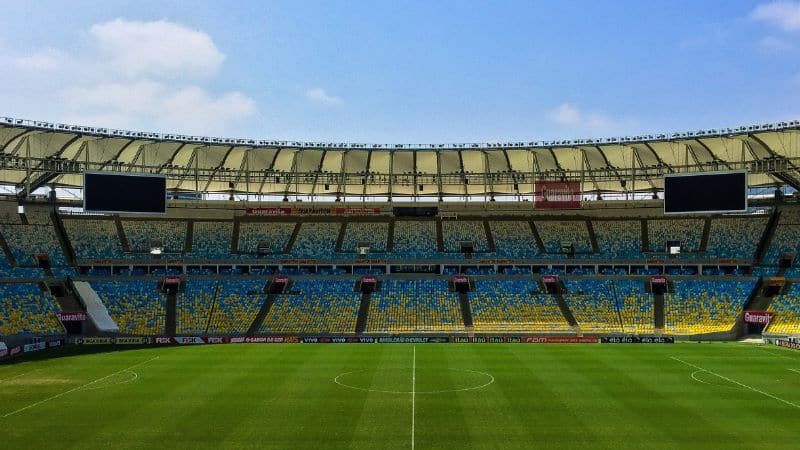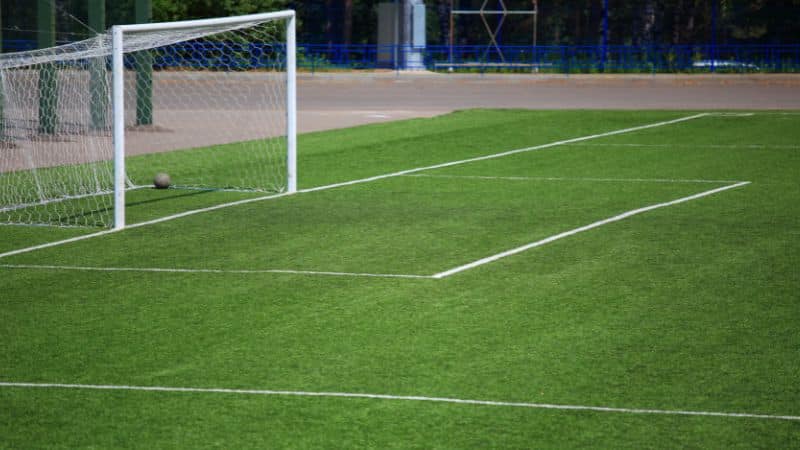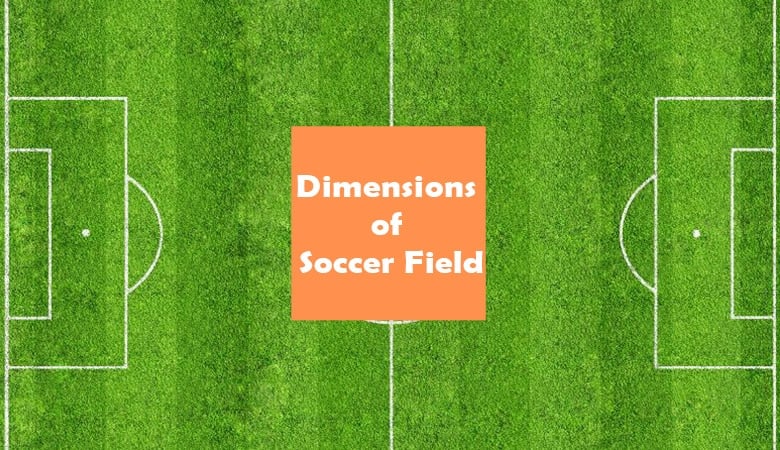Over 520 million soccer fans worldwide stay glued to their televisions to watch the FIFA World Cup tournament every four years.
This tournament started in 1930 and included over 32 teams in stadiums chosen in a host country.
Considering it is a global event, teams, coaches, and participants must follow specific rules and regulations. Even the host country has to revamp its stadiums to meet the FIFA standards.
Soccer, also known as football in other parts of the world, is one of the games played on extensive fields, only ranking behind Polo. Therefore, for sports enthusiasts, let us dig into the dimensions of the football field and how it compares to various tournaments.
FIFA Field Guidelines
FIFA is the Federation International de Football Association (International Federation of Association Football. This is the body that governs football, including World Cup tournaments. According to FIFA, soccer fields must adhere to specific criteria. Therefore, the World Cup field is considered the official dimension of FIFA.
The length should be between 110-120 yards (100-110 m) and the width between 70 and 80 yards (64 and 73 m). Here are some elaborate measurements for the actual World Cup Dimensions.
Field Markings Dimensions
Although different sizes, soccer fields must be rectangular with continuous line markings. At the center of the line dividing the field into two halves, the circle has a radius of 10 yards (9.15 meters).
Furthermore, all the lines that restrict the field sections must be the same width. All lines must therefore be 12 centimeters wide (5 inches). In addition, both goal lines on a soccer field should be the same length as the goalposts and crossbars.
Goal Dimensions
By Manuel Heinrich
CC BY-SA 3.0, Link
FIFA stresses that goals must be accurately placed at the center of the goal lines. The goal posts can be either steel, wood, or reinforced plastic.
The measurements must therefore be equal for all posts. Each post should be 8 feet (2.44 m) high from the ground to the crossbar’s lower edge. The space between the posts should be around 8 yards (7.32 meters). The depth and width of the crossbar and goalposts must be equal without exceeding 5 inches (12 centimeters)
Goal Area Dimensions
The soccer rulebook indicated that two lines should be drawn from the goal line 6 yards (5.5 m) from the inside of each goalpost. The lines must extend around 6 yards (5.5 m) into the field and then be connected to an 8-yard (7.32-m) line parallel to the goal line.
Penalty Area Dimensions
After the goal line, two lines are used as the penalty area. These lines are 18 yards (16.5 m) further from the goalposts. The lines extend into the field, connected to a line parallel to the goal line. The penalty kick spot is 12 yards (11 meters) from the center of the goal.
On the penalty area’s exterior is an arc of a circle drawn from the center of each penalty mark. The radius of this arc is 10 yards (9.15 meters).
Corner Area Dimensions
At the point where the goal line meets the touchline, a quarter circle demarcates the corner area. The quarter circle is drawn inside the soccer field with a radius of 1 yard (1 meter) from each flag post.
On each corner of the playing field, there are flag posts to indicate the corner area. Each post must meet a minimum height requirement of 5 feet (1.5 m). There are also halfway lines marked with flag posts placed 1 yard (1 m) away from the touchline and the field.
Technical Area Dimensions
There is an area marked where players and officials sit on the football field. This is called the technical area, and not all soccer fields have this designated space. The area should be only 1 yard (1 m) from either side of the seating area. It should also be around 1 yard (1 m) away from the touchline.
What is the Length of the Grass in a WC Soccer Field?

The grass on a soccer field is usually 25-30 millimeters long, especially for elite-level games like the world cup. The grass is usually cut at this length to show the visible stripes, which makes it easier to spot offside plays since they are vertical references for the officials.
Dimensions from Touchline to Midfield
The midfield line, also known as the halfway point of a soccer pitch, divides the field into two sides. This line is essential for kickoffs because each team must be on their respective side. In addition, the line indicated offside since a player can be offside in their opponent’s half. The distance between the touchline and the halfway line is between 49 and 65 yards (45 and 60 meters), depending on the total length of the field.
Soccer Thirds Dimensions
Even though there is only one halfway line separating the football field into two halves, officials further break it down into three parts. Soccer thirds are drawn to explain where there is action. Coaches use the thirds to plan drills, strategies, and plays. There is the defensive third, middle third, and attacking third.
Defensive Third
This third of the field is the side where a team’s own goal and penalty area. One team’s attacking third is the other team’s defensive third. The dimensions of a defensive third are from 32-44 yards (30 – 40 m) wide, and the length is the entire field’s length.
Middle Third
The middle third is the middle of the pitch around the halfway line. This is where midfielders like moving between the defensive and attacking third. The middle third is the place where the contest is most heated because the defensive side must prevent entry to the attacking side. The width of the middle third is between 32-44 yards (30 and 40 m).
Attacking Third
The attacking third is where the opposing team’s penalty and goal area is. Sometimes the attacking third is also called the final third because it is the final place the offensive team must go to score a goal. The attacking third is equal to all the other thirds, with the width being 32-44 yards (30-40 m) wide.
History of Soccer Field Dimensions

During the invention of soccer in the 1800s, the fields would be over 200 yards (182 m) long and 100 yards (91.4 m) wide. Flags were used to mark the boundaries until 1882, when borderlines and the halfway line were introduced to the field. Then, in 1887, the center circle was introduced.
In 1997, FIFA made some of the most significant changes to soccer fields by mandating that international fields be 110 yards (100.5 m) long and 70 yards (64 m) wide. Today the touchline should be 100 yards (90 meters) or 130 yards (120 m) long. In addition, the goal line/width should be a minimum of 50 yards (45 m) and a maximum of 100 yards (91 m).
Is a World Cup Soccer Field Bigger than an American Football Field?
While soccer and American football are two different sports, they share a few similarities. The major similarities lie in the shape of the field and the games played. In terms of size, the soccer field is bigger than a football field. The length of the fields is similar, but the widths vary.
An American football field is 53⅓ yards (53.8 m) wide, while a soccer field is between 70 and 100 yards (64-100 m). Therefore, a world cup soccer field has a bigger surface area than a regulation football field. The field markings and goalposts are also different.
Other Soccer Field Dimensions
4v4 Field Dimensions
The standard dimensions for a 4v4 soccer field are between 25-35 yards (23-32 m) long and 15-25 yards (14-23 m) wide. These measurements are not strict and could be adjusted per the state and soccer association. The goalposts are 6 ft. long and 4 ft. high.
5v5 Field Dimensions
5 vs. 5 soccer is one of the commonly played game variations with dimensions as 40 yards (37 m) long and 30 yards (27 m) wide. The dimensions are also different depending on the region, with the FA in England stating that 5v5 soccer fields should be 40 yards (36.6 m) long and 30 yards 27.5 m.
6v6 Field Dimensions
A 6v6 soccer field’s recommended dimensions are around 40-60 yards (37-55 m) long and 35-45 yards (32-41 m) wide. The center circle is about 14 yards in diameter, with the penalty area being 10 yards (9.1 m) by 22 yards (20 m). Their goals are also shorter than standard football posts at 18.5 feet long and 6.5 feet wide.
7v7 Field Dimensions
A 7v7 soccer field is between 55 and 65 yards (50-59 m) long and 35 to 45 yards (32-41 m) wide. The center circle is 16 yards (14.6 m), with the penalty area measuring 12 by 24 yards (11-22 m). The penalty spot is 10 yards (9 m) away from the goal, and the penalty arc is 8 yards (7 m) from the penalty spot. The goals posts should be 6.5 by 18.5 feet as per the requirements.
9v9 Field Dimensions
The recommended length dimensions of a 9v9 touchline are 70-80 yards (64-73 m) long and 45-55 yards (41-50 m) wide. The center circle diameter is 16 yards, with the goal area being 5 by 16 yards. The penalty area is 36 yards long and 14 yards wide, marking the penalty spot 10 yards away from the goal. The penalty arc is 8 yards (7.3 meters) from the penalty spot. Goal posts are supposed to be 21 feet long and 7 feet wide, 6.4 meters by 2.1 feet.
11v11 Field Dimensions
FIFA and IFAB always guide the 11v11 field dimensions, and the measurements apply to national and international competitions. The field length is between 100-130 yards (90 and 120 m) and the width between 50 and 100 yards (45 and 90 m). The center circle diameter is 20 yards, and the penalty area is 44 yards long and 18 yards wide.
The measurements given here are estimations but can be used as a reference for actual fields because the dimensions are credible. If you are a soccer fan, at least you will feel proud to learn more about the field in which your favorite players participate. The soccer field dimensions also impact gameplay because they can affect the distance a player covers while playing.
The dimension of stuff has been an interest of mine ever since I was a child. What I believe is most fascinating about the dimension of stuff is how extremely long, tall and wide some objects are both on earth and in the universe.



